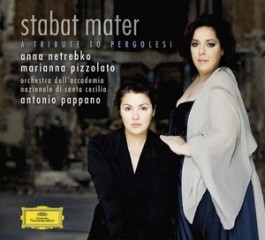Pergolesi – Stabat Mater (Pappano) [2001]
Pergolesi – Stabat Mater (Pappano) [2001]

Nel chiuso centro 1. Nel chiuso centro 2:03 2. Euridice e dove 8:33 3. Si, che pietà non v'è 2:31 4. O d'Euridice n'andrò fastoso 3:29 Li prodigi della divina grazia nella conversione e morte di san Guglielmo d'Aquitania Sinfonia 5. Allegro assai e spiritoso 1:26 6. Andante 1:36 7. Allegro 1:56 Questo è il piano, questo è il rio (Cantata for alto and strings) 8. Questo è il piano 6:51 9. Oh, dolce tempo 0:50 10. Torna, torna a Cocito 1:43 11. Se nel dir son menzognero 3:36 Stabat Mater 12. Stabat mater 4:32 13. Cujus animam 2:03 14. O quam tristis 2:11 15. Quae moerebat 2:08 16. Quis est homo 2:43 17. Vidit suum 4:08 18. Eja mater 1:46 19. Fac ut ardeat 2:07 20. Sancta mater 5:41 21. Fac ut portem 3:34 22. Inflammatus 1:47 23. Quando corpus 4:34 Anna Netrebko - soprano Marianna Pizzolato - contralto Orchestra dell'Accademia Nazionale di Santa Cecilia Antonio Pappano – condutor
Baroque music is not the usual province of soprano Anna Netrebko, or contralto Marianna Pizzolato, or conductor Antonio Pappano, or the Orchestra dell'Accademia Nazionale di Santa Cecilia, Roma, so the listener might approach this tribute to the 300th anniversary of Giovanni Battista Pergolesi with some skepticism, but the performers do a terrific job. The orchestra uses modern instruments, so this is never going to be mistaken for a recording by Baroque specialists, but everyone involved approaches the challenge with such sensitivity and such evident excitement that listeners who don't demand absolute adherence to cutting-edge developments in early music practice are likely to be swept up. Netrebko is in fine voice, but some of the music lies low for her, and there are few opportunities for high-flying virtuosic vocal display, so this album is probably not the best introduction to her gifts. The intensely focused and deeply felt characterizations for which she is known are here, though, and serve the music well. Contralto Marianna Pizzolato actually makes a stronger impression because the music is beautifully situated for her warm, earthy, passionately expressive voice. Netrebko and Pizzolato sound fabulous together; in their duets in the Stabat mater each maintains the distinctiveness of her personality but their blend is gorgeous and conveys the depth of their connection in witnessing and describing a profound tragedy. The live recording was made at the Baden-Baden Festspielhaus (which was originally a railroad station), a hall large enough to seat 2,500 people. Its spacious resonance is for the most part conducive to the music, but at the end of some movements, the penultimate chord is still hanging around when the final chord is sounded, to dissonant effect. ---Stephen Eddins, allmusic.com
download (mp3 @VBR kbs):
Zmieniony (Niedziela, 18 Marzec 2018 16:08)








